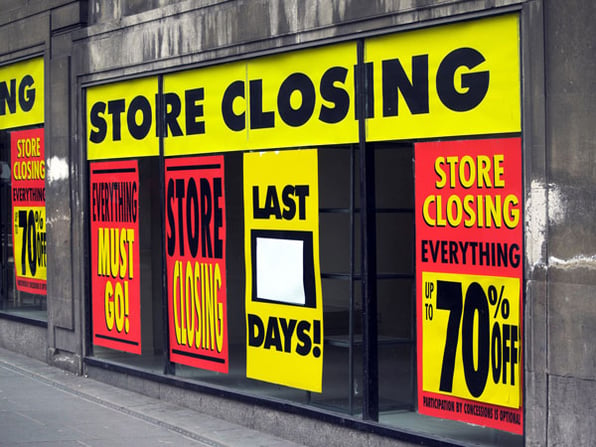How to Survive the (Bogus) Retail Apocalypse
I live in a small town and our only shoe store, Payless Shoes, recently went out of business. And while their liquidation sales were awesome – $2 per pair boys dress shoes? I bought one in every size! – now what?
Between my elementary-aged kids’ ever changing shoe sizes, and my inability to be comfortable in anything more confining than a flip flop, I never buy shoes online.
In case you missed it, Payless Shoes recently closed every store and its ecommerce operations in US and Canada “as a result of a challenging retail climate.”
If you believe the news, you’d probably say Payless is just the next chain in a long line of mega-retailers to fall victim to the dreaded retail apocalypse.
I don’t love the idea that I have an hour+ drive now to the next closest shoe store. But news articles from sources like the Wall Street Journal to Fortune predict an even more dire future: one without shoe stores at all, where my only option will be to order online and hope. In fact, many of these stories would have you believe that retail as we know it will soon be gone forever, leaving a wasteland of abandoned malls that would appear more at home in a zombie movie.
This has many retailers afraid for their lives. But really there’s no need to panic. Even if the environment is hostile to antiquated business practices, brands willing to channel their inner Daryl Dixon and adapt to the changing retail landscape can survive and thrive.
Retailpocalypse? Is that Like a Zombie Apocalypse?
The term retail apocalypse or “retailpocalypse” started gaining popularity in 2017 but describes a phenomenon that has been plaguing the retail world since 2010. Stores are closing up shop and going out of business across the US. Some brands are left with only a fraction of the locations they once had. Some brands are gone for good.
Its victims include many big and recognizable names. Do you even remember Blockbuster, RadioShack, Walden Books, Gymboree or Toys R Us? Just like with any zombie movie, these brands were reduced to a bloody splash across the screen, the memory of a messy death.
Other brands are dying slowly, struggling for years to stay profitable. But many are predicted to succumb in 2019, like Victoria Secret, JCPenney and Gap.
In fact, analysts are predicting the demise of more than 75,000 clothing, electronic and furniture stores in the next 7 years.
Experts are attributing the shift to everything from Millennial obsession with experiences over material possessions to income inequality and lack of disposable income.
But most often, it’s blamed on the rise of online sales and competition from mega-corporations like Amazon.com and Walmart.com.
E-commerce is projected to make up 25% of total retail sales by 2025 (up from its current 10%.) They say those equivalent sales dollars will no longer be spent in brick and mortar stores, forcing their closure.
After all, Amazon.com alone added $35 billion in US sales last year, about the equivalent of 77,000 stores. And it recently declared Amazon Prime Day 2019 to be its biggest shopping event ever, surpassing Black Friday and Cyber Monday combines with over 175,000 items sold.
The future certainly looks grim... IF you look only at these stats instead of seeing the bigger picture.
In-Store Retail is Not Really Dying
While many stats portent the inevitable demise of in-store retail, there are more that prove it is not just alive, but thriving.
Online sales grew faster in 2018 than in-store sales (10% for online vs. 4.2% overall sales). However, in-store sales still grew, and still make up the vast majority of total retail sales.
Why? Consumers aren’t ready to dive head first into an online only shopping experience.
 When surveyed, over half of US shoppers said having a nearby physical store presence is important when buying online. Almost more telling, is that Millennials (the generation most drawn to technology) see the greatest value in a physical presence to back up their online purchases (over three fifths.)
When surveyed, over half of US shoppers said having a nearby physical store presence is important when buying online. Almost more telling, is that Millennials (the generation most drawn to technology) see the greatest value in a physical presence to back up their online purchases (over three fifths.)
Partially, this is because people don’t fully trust online sales. Particularly with clothing, home goods and electronics, people want to try before they buy to ensure fit, quality, usability, etc. They also want to know there’s a trusted return system in place in case it doesn’t work out.
For example, some online-only shoe brands may look on the surface like they are successfully taking over the industry. But when it comes to women’s shoes, return rates are reported at 25% to nearly 50%. (Why am I not surprised? Oh yah, because I refuse to buy a shoe I haven’t tried on.) This predicts that many industries can’t survive without an in-store presence.
In fact, many real estate vacancies are being filled by a new type of business: click-to-brick locations. These are physical stores opened by previously e-commerce only brands, and research predicts that 850 new locations will open in the next 5 years.
Even the mighty Amazon is investing in brick an mortar. In addition to buying Whole Foods, Amazon has partnered with Kohl's, to the mutual benefit of both. Kohl's enjoys valuable foot traffic while Amazon can give customers an option for easy and free in-store returns. And Amazon's trial line of innovative high-end grocery stores, AmazonGo, is predicted to number in the thousands by 2021. Why go to the effort when Amazon is already so successful? Founder and CEO Jeff Bezos claims its because "nearly 90% of retail remains offline, in brick and mortar stores."
Death is Not Inevitable for Businesses Willing to Evolve
With some extremely recognizable and widespread brands failing, others are coming to the conclusion that it’s only a matter of time before the rest of retail follows suit.
However, the failure of a brand cannot be blamed entirely on the current market. If brands want to survive, they must take their share of responsibility for not listening to its customer’s needs and adapting when necessary.
For example, Sears has long sought to maintain its image as an appliance sales store. Some critics, however, have suggested that Sears hasn’t done enough to strengthen its grip on customer relations – particularly in the areas of installation, maintenance and customer service. These elements are of particular interest to new owners of things as complicated and high-value as appliances. Therefore, much Sears’ customer base was lured away by businesses offering 360 degree support.
And my poor Payless fell victim to its own poor decisions too. During the recession, Payless established itself as a discount shoe provider with low prices and steep sales. Once the economy recovered and people started having more spending money, Payless raised prices and discounted less, all while offering the exact same product. Its audience, unwilling to pay more, sought discounts elsewhere.
Luckily, there are even more examples of retailers thriving in this new market. What are they doing that can serve as an example to others?
Use of – But Not Dependence on – Technology
Many stores prove that online and offline sales are at their best when they maintain a symbiotic relationship. By using the strengths of each type to support overall sales, businesses with a hybrid approach are not only competing with Amazon, but are predicted by some to be the real future of retail.
Surviving retailers like Kohl’s and Walmart have online shopping options which they support heavily at their physical locations. By offering services like shop online, pick up in store or return in store, they bridge the gap of customer trust. Customers can order online with more confidence, knowing have options for easy resolution should their “blind” purchase not work out.
Some clothing retailers are simply shrinking their stores. They still give shoppers the opportunity to try clothing on for fit and style, but instead of stocking endless design styles and colors in every size, customers can order online once they know what they want. It’s just another example of keeping costs low without sacrificing the customer experience: a win for everyone.
And, even though it is important to give customers every option to encourage purchasing at their own convenience, it’s also important to remember that most big brands still only attribute a fraction of their sales to online, with the majority being in store.
Plus, retailers are finding an added benefit of encouraging customers to shop online and pick up in store. In an example of upgraded marketing practices, Target offers discounts through the Access network not only to reach new users and generate incremental sales, but also to encourage existing users to shop Target.com more frequently in order to pick up at local stores. This practice not only reduces overhead costs, it allows Target to track purchases and give more individualized, targeted promotions in the future. The best discount programs assist businesses in forward-thinking solutions.
Emphasis on the Experiential
Like the generations before them, younger consumers continue to make their mark on the retail landscape. Over 72% of Millennials prefer to spend money on experiences rather than physical objects. Yet they are still shopping, and retailers willing to emphasize the experience in “shopping experience” are attracting this generation into their stores.
 Best Buy, for example, continues to grow despite competition from Amazon and other online providers, reaching all time stock highs at a time when other businesses have announced bankruptcy. How? They’ve revamped their stores to focus on the experience. Best Buy partnered with third party retailers like Google and Samsung to display all their latest gadgets, which customers could play with and test out. Plus, employees are no longer trained primarily as salespeople, but as experts that consult with shoppers – offering value in place of persuasion.
Best Buy, for example, continues to grow despite competition from Amazon and other online providers, reaching all time stock highs at a time when other businesses have announced bankruptcy. How? They’ve revamped their stores to focus on the experience. Best Buy partnered with third party retailers like Google and Samsung to display all their latest gadgets, which customers could play with and test out. Plus, employees are no longer trained primarily as salespeople, but as experts that consult with shoppers – offering value in place of persuasion.
Best Buy isn’t the only brand focusing on experience. Apple Stores encourage customers to hang out and test new products. Nike is now encouraging customers to exercise at some locations and discover products customized to their work out preferences.
Kohl’s has revamped several stores to share space with Planet Fitness, making it easy for shoppers to, say, try on a new shirt after their morning workouts. This approach creates and commingles experiences for a generation who actively seek them.
And some in-store locations are able to resist the impact of online just by their very nature, like restaurants. Sure, customers can order from a restaurant through GrubHub or Uber Eats and have food conveniently delivered to their doors. But as any restauranteur will tell you: eating and dining are two very different things. The nature of the meals may change, but it’s unlikely that people will tire of the experiences associated with dining out, meeting with friends and leaving the house for the unique environment only restaurants can provide.
The same is true for movie theaters. Though it’s easy to stream rentals or binge entire seasons of TV shows in the comfort of one’s own home, that doesn’t prevent people from flooding theaters for the experience of seeing the newest release on opening weekend and discussing with friends and family.
Still Scared? Add Value!
Customers are choosier than ever. So it’s easy to see why businesses may feel like the market is out to get them.
At the end of the day, consumers abandon brands when they feel they are not getting enough value for their dollar.
Consumers are no longer satisfied with simply great products OR great customer service OR ethical business practices OR membership perks. They want it all plus that extra special something they can’t get anywhere else.
The answer is to keep delivering value and evolving relentlessly. Listen to your customers. Then shore up your value according to what they tell you, be that improving product quality, better customer service or offering value added benefits.
For even more information on the changing economy and how to stay current in your business plan, member benefits for associations and more, check out these other articles:
- Millennials, Gen Z & Beyond: Are Your Member Benefits Still Relevant?
- Engagement Trends 2019: Why Membership Discount Platforms Matter So Much to Organizations
- Stats Reveal 6 Truths About the Future of Loyalty
Topics: Customer Engagement, partnership marketing, Discount Programs, Retail, coupon marketing, coupon strategies, customer loyalty, Customer Success, loyalty programs

Written by: Kendra Lusty









.jpeg)







Share your Comment.